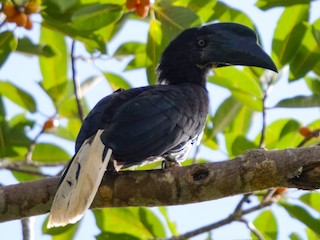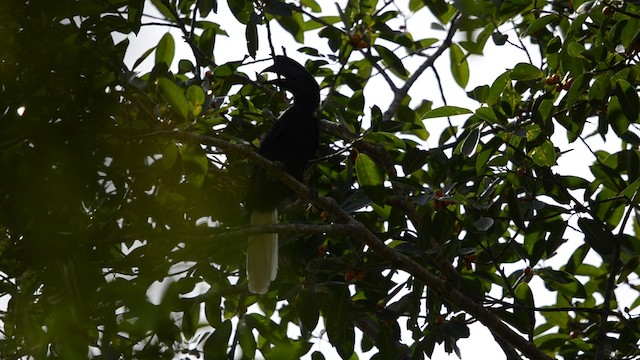Sulu Hornbill Anthracoceros montani Scientific name definitions
- CR Critically Endangered
- Names (23)
- Monotypic
Text last updated May 1, 2015
Sign in to see your badges
Species names in all available languages
| Language | Common name |
|---|---|
| Bulgarian | Сулуанска птица носорог |
| Catalan | calau becfalçat de les Sulu |
| Croatian | suluski kljunorožac |
| Czech | zoborožec suluský |
| Dutch | Suluneushoornvogel |
| English | Sulu Hornbill |
| English (United States) | Sulu Hornbill |
| Estonian | tawitawi sarvlind |
| Finnish | sulunsarvinokka |
| French | Calao des Sulu |
| French (Canada) | Calao des Sulu |
| German | Suluhornvogel |
| Japanese | ハシグロサイチョウ |
| Norwegian | suluhornfugl |
| Polish | dzioborożec czarny |
| Russian | Белохвостая птица-носорог |
| Serbian | Kljunorožac sa arhipelaga Sulu |
| Slovak | zobákorožec talusi |
| Spanish | Cálao de las Sulu |
| Spanish (Spain) | Cálao de las Sulu |
| Swedish | sulunäshornsfågel |
| Turkish | Sulu Boynuzgagası |
| Ukrainian | Птах-носоріг сулуйський |
Anthracoceros montani (Oustalet, 1880)
Definitions
- ANTHRACOCEROS
- montani
The Key to Scientific Names
Legend Overview
Field Identification
50 cm. Medium-sized hornbill, all black but for white tail . Male with bill and blade-like casque black; bare skin around eye and bare throat skin black; eyes creamy. Female smaller, bill and casque smaller, eyes dark brown. Juvenile with smaller bill plain greenish-yellow, no casque, grey circumorbital skin.
Systematics History
Subspecies
Distribution
Sulu Archipelago: certainly present on Tawitawi, probably extinct on Jolo and almost certainly extinct on Sanga-Sanga (1). Records from mid-1990s (1) on Tandubatu, Dundangan and Baliungan.
Habitat
Evergreen dipterocarp forest , in lowland and highlands.
Movement
Probably sedentary.
Diet and Foraging
Reported to eat fruit, small lizards and some insects, but few details. Recorded in pairs at fruiting trees in forest, or visiting isolated trees among cultivation.
Sounds and Vocal Behavior
A fast series of nasal cackles ending in a few louder notes “ca-ca-ca-ca-ca-CRAW-CIAW”, with the overall rhythm reminiscent a domestic chicken.
Breeding
No documented information. On Tawitawi, pair with immature seen in Sept; nest in tall, large-diameter tree; reported clutch size 2, with fledging reported in May–Jun.
Conservation Status
CRITICALLY ENDANGERED. CITES II. Restricted-range species now seemingly confined to Tawitawi: present in Sulu Archipelago EBA. Considered common to abundant in late 19th century, it is now probably the world’s most threatened hornbill species, likely on the verge of extinction. Population currently estimated at fewer than 20 pairs in main mountain range on Tawitawi , with four individuals seen in 2009 BirdLife International (2015) Species factsheet: Anthracoceros montani. Downloaded from http://www.birdlife.org on 01/05/2015. ; no records from Jolo since 1883, and probably extinct here; formerly rare on Sanga Sanga I, now almost certainly extinct. Islands of Sulu Archipelago, where this is the only hornbill present, were relatively little logged until latter part of 20th century; by 1994, however, Jolo had been logged, probably resulting in disappearance of the last hornbills here, and remaining forest on main island of Tawitawi was being rapidly logged and species was rare and local, with last degraded patches of lowland forest planned for conversion to oil-palm and rubber plantations; in 1995, reported from small islands of Tandubatu, Dundangan and Baliungan, in Tawitawi group, but in numbers insufficient to indicate sustainable populations. Is still hunted for food, cagebird trade and exhibition, especially on Tawitawi. Suspected to have been widely shot during human armed conflict in early 1970s, both for food and merely for target practice; continuing political unrest poses serious obstacles to any conservation work. Surveys, and studies of species’ life history and biology, including captive studies, urgently needed to prevent its imminent extinction.

- Year-round
- Migration
- Breeding
- Non-Breeding














































